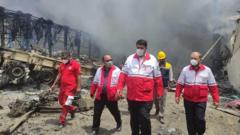In Iran, sorrow is swiftly transforming into outrage as the country grapples with the aftermath of a devastating explosion at its largest commercial port that has led to at least 40 fatalities and over 1,000 injuries. The incident occurred on Saturday morning at Shahid Rajaee port, prompting countless individuals to rush to hospitals across the nation to donate blood for victims.
By Sunday, the aftermath saw violent fires still raging and a menacing cloud of toxic smoke hanging in the air. The Iranian health ministry has advised residents in neighboring towns and cities to remain indoors and wear protective clothing as a precaution. In Bandar Abbas, the southern city near the port, all schools and offices were closed to expedite emergency response efforts, according to state television.
A festival initially aimed at community celebration turned mournful as attendees transitioned to solemn remembrance for those lost in the tragedy. Authorities announced a national mourning day for Monday, followed by two additional days of mourning in Hormozgan province.
The scope of the explosion’s impact is not only physical but also political, as criticisms toward governmental accountability are escalating. Some reports from Ambrey Intelligence suggest that the explosion was triggered by the improper handling of a shipment of solid fuel intended for military missiles. Claims emerged that sodium perchlorate – a primary ingredient in solid fuel – was stored at the port, adding to existing tensions among the populace over the management of hazardous materials.
While Iranian President Masoud Pezeshkian was at the scene on Sunday, promising to investigate, widespread skepticism remains as to whether appropriate oversight was in place. The Defense Ministry has denied that military-related cargo was involved. However, troubling questions linger: how was a significant quantity of potentially explosive materials permitted to remain unattended at the port?
The economic ramifications of the incident are also cause for concern, as Shahid Rajaee port is responsible for handling nearly 80% of Iran's imports. Subsequently, fears of forthcoming food shortages emerged, but officials later sought to downplay these warnings by clarifying that only a section of the port was affected and that other operations were functioning normally.
Images from the scene depict helicopters battling the flames and firefighters responding amid toppled and charred cargo containers. Roads leading to the area have been restricted as efforts to contain the disaster continue.
In a sign of international solidarity, condolences poured in from various nations including the United Arab Emirates, Saudi Arabia, and Russia, while Russian President Vladimir Putin announced the deployment of firefighting aircraft to aid in response efforts. Amidst this turmoil, diplomatic conversations are ongoing between Iranian and US delegations about Tehran's nuclear program, with progress noted before the catastrophe struck.
As Iran faces grief and anger, the immediate focus remains on addressing the tragedy's causes and the implications for the nation's future.


















